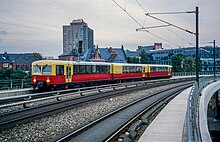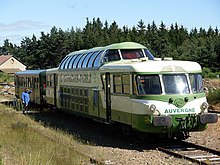Observation railcar
Railcars that serve tourist purposes and have many glass surfaces for better all-round visibility for passengers are referred to as observation railcars or panorama railcars . Like corresponding passenger coaches - coaches with a glazed viewing platform ( AD4üm-62 , Domecars ), panorama coaches ( Apm61Pano ), pulpit coaches , etc. - they belong to the observation coaches and, due to their motorization, belong to the self-driving vehicles.
Germany
Rail cars
- The best-known German observation railcar was the electric railcar "Gläserner Zug", which was on the tracks in and around southern Germany until 1995. The wagon factory Fuchs had in 1935 and 1936, two such vehicles to the German Reichsbahn supplied (DR). The Railcar ET 91 02 was burning on March 9, 1943 during a bombing raid from the ET 91 01 came after the Second World War to the German Federal Railways (DB). On non-electrified routes, it was towed by diesel locomotives . It was badly damaged in an accident at Garmisch-Partenkirchen station and has not been roadworthy since then.
- Analogous to the ET 91 series, the DR von Fuchs acquired one diesel multiple unit from Fuchs in 1936 and two more diesel railcars in 1939 for use on non-electrified routes. Railcar 137 462 was destroyed in a bomb attack in 1944. The DB took over the remaining two vehicles and renamed them VT 90 500 and 501, in 1960 and 1962, respectively, they were retired.
- In 1999 the "Panorama-S-Bahn" was created from vehicles of the Berlin S-Bahn . Two quarter-trains of series 477/877 served as the basis for the three-piece train set. Until 2009 it ran on Fridays and on weekends in special traffic between the regular trains in the Berlin S-Bahn network, and has been inactive for several years.
Tram cars
- Light rail vehicles of the types GT8-80C and GT8-100D / 2S-M
- The middle parts of some of the vehicles of the GT8-80C and GT8-100D / 2S-M series of the Karlsruhe Stadtbahn have roof edge glazing.
- Railcar 502 of the Stuttgart tram
- The “glass railcar” of the Stuttgart tram was a unique piece. On the occasion of the Reichsgartenschau planned for 1939 , she converted the railcar 550 into the observation railcar 502 in her main workshop in Ostheim . Car 550 belonged to type 17.2, a series of twelve vehicles that was built in 1913 for the newly opened line 8 ("Ostring") and parked in 1935.
- The railcar became a one-way vehicle and received windows instead of the left-hand doors. The lantern roof was replaced by a largely glazed barrel roof , and the partition walls to the platforms were removed in favor of a continuous passenger area. He received 25 padded bus seats (single seats on the right and double seats on the left), which were arranged in the direction of travel. In contrast to the line vehicles, it was painted light green in the lower part.
- During the garden show it was used for guests of honor as well as for city tours on routes with turning loops . During the Second World War, it mainly served the convalescent wounded for special trips. On the night of November 12th to 13th, 1944, he was burned to death in an air raid in depot No. 4 in Stuttgart-Ostheim.
Switzerland
By the company Stadler Rail derived meterspurigen three-part multiple units of the type Spatz , an acronym for S chmalspur- Pa norama- T rubbed z ug. As with the Karlsruhe vehicles, the middle parts are provided with roof edge glazing. Ten of these are used by Zentralbahn as ABe 130 , and two more by Transports de Martigny et Régions (TMR). The vehicles of the TMR designated as Beh 4/8 have a mixed adhesion and gear wheel operation , they operate with 850 volts DC voltage on a side busbar .
France
- In 1956, the French state railway SNCF ordered ten diesel multiple units with a viewing platform above the engine room and the luggage compartment. The vehicles, which were delivered until 1959, were used in express train services until 1985, mainly on scenic routes . Four of the railcars have been preserved, one as a spare parts donor and one operational at the Train touristique du Livradois-Forez museum railway .
- The narrow-gauge Z 850 series vehicles acquired by SNCF between 2005 and 2008 for the Saint-Gervais – Vallorcine line are of the Stadler Spatz type. They correspond to the multiple units of the TMR, but have no gear drive.
Italy
- A diesel railcar of the Italian series ALn 772 (ALn 772.3240) was converted into a panorama railcar in 1948. The vehicle with the new road number ALtn 444.3001 and the nickname "Belvedere" was used in seasonal traffic from Milan to Sanremo , but was dismantled to ALn 772 in 1965.
Web links
- Automotrice Diesel ALtn 444.3001: description, technical data and photo of the Italian ALtn 444.3001
Individual evidence
- ↑ Gottfried Bauer: Stuttgart's "Gläserner" . In: Tram magazine . No. 9 , 2008, p. 78 f .






